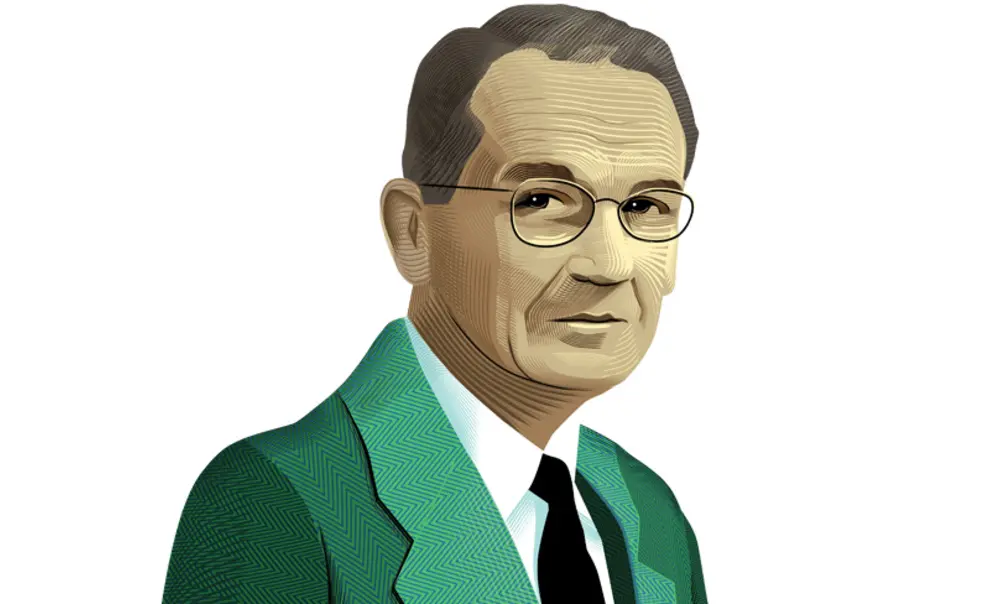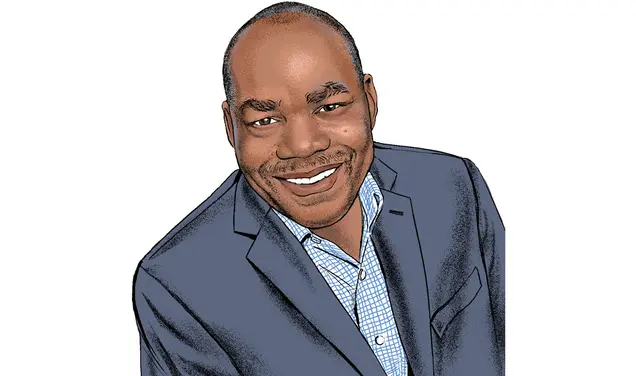A Tragic Candidate in the Princeton ‘Conclave’ for University President
E. Harris ‘Jinks’ Harbison 1928
Following the April death of Pope Francis, interest in the papal conclave — the voting process by which the College of Cardinals selects the next leader of the Catholic Church — took on a fever pitch, so much so that the 2024 film Conclave, based on Robert Harris’ 2016 novel of the same name, surged 3,200% in streaming views. Both the film and novel take a pulpy approach to dramatizing the secretive papal election, with intrigue and plot twists straight out of an Agatha Christie potboiler.
As it turns out, Conclave has a Princeton counterpart. In 1958, Princeton English professor and Hemingway biographer Carlos H. Baker *40 published a suspense novel on a similar theme, about the selection process of a university president at a thinly veiled Old Nassau. His book, titled A Friend in Power, dramatized the presidential committee machinations at “Enfield University,” a fictional Ivy League institution “somewhere in the radius of New York City.” The novel follows a Voltaire scholar named Ed Tyler who is appointed to the selection committee. Though Tyler lobbies for his friend Cos Cobb, a biologist who served the Office of Naval Research in World War II (seemingly modeled on geologist Harry Hess *32), Tyler is increasingly disturbed by Cobb’s frequent absences, as well as an encounter with Cobb in which he discovers the candidate arm in arm with a striking woman other than his wife.
The author participated in the real-life faculty committee that chose Robert Goheen ’40 *48 to succeed President Harold Dodds *1914 in 1957. And though Baker’s novel is a work of fiction, it was — according to a tantalizing 1996 essay by Jerrold Seigel *63 — inspired by at least one other Princeton figure: history professor E. Harris Harbison 1928, popularly known as “Jinks.” As a former student of Harbison, Seigel argued that his mentor inspired the novel’s competing candidate character of Gus Atterbury, “whom the search committee would have chosen to be president of the university had medical worries not interfered.”
Harbison certainly had the pedigree to be president. The seventh member of his Pennsylvania-based family to attend Princeton, Harbison was president of the Triangle Club during his undergraduate career and served as class valedictorian. After his Ph.D. at Harvard, he returned to Princeton and joined the history department. His first book was a lauded work of diplomatic history, Rival Ambassadors at the Court of Queen Mary (1940), but over the course of his career, he turned toward broader subjects in 16th century European history, becoming the department’s “in-house” Christian scholar.
According to Seigel, Harbison was a popular instructor known for always asking the “right questions” in precepts; independent scholar George Newlin ’52 told Town Topics in 2006 that Harbison typically left lecture audiences in “awed silence.” Harbison was also active in undergraduate-faculty relations, spearheading a “Harbison Report” in 1950 that advocated for the construction of a “campus center,” a promise finally fulfilled by the remodeling of Palmer Hall into Frist Campus Center in 2000.
Though Harbison’s administrative leadership had made him a candidate to replace Dodds in 1957, he developed cancer around that time and died in 1964 at age 57.
The title of Baker’s novel derived from a quote by 19th century American historian Henry Adams, who wrote in his autobiography that “a friend in power is a friend lost.” Over the course of the novel, Tyler, the book’s protagonist, agonizes over the potential of losing his friend Cobb to the presidency. Spoiler alert: The “Enfield” conclave concludes on the biggest twist of all with the trustees electing Tyler to the post, mirroring the way Goheen was supposedly blindsided by his own selection.
In a 1966 address for the Danforth Foundation, a now-defunct nonprofit that awarded teaching grants named after Harbison, Goheen honored his late, erstwhile competitor. “Somehow the maturity of the teacher gets translated to the students so that they go beyond their years,” Goheen said. “This was one of the qualities of Jinks Harbison: His maturity was manifest, and he conveyed it in everything he wrote and said.”












7 Responses
C. Thomas Corwin ’62
4 Months AgoA Tribute to E. Harris Harbison 1928
I was a student in Professor Harbison’s “Renaissance and Reformation” course in the early 1960s. I also had the good luck to be assigned to a preceptorial that met weekly in his office. Although Harbison was a very good lecturer, it was in the preceptorial that he excelled. I remember his asking us at the outset of one for them, “Does anyone here understand Martin Luther?” I was not inclined to raise my hand because the question seemed to be too open ended for me to risk making a fool of myself. And that’s what happened to the one who went first. Harbison knew Luther to be a man so unlike any of us that not even he could truly claim to fully “understand” him. For Harbison, Luther was both obsessed and terrified by the thought of eternal damnation. And, for much of his life, Luther felt damned. Harbison led us step by step to this conclusion by the end of the precept — not by telling us what to think but by eliminating one-by-one our various half-baked attempts to get an understanding of this 16th century man we may previously thought we understood.
But my most unforgettable Harbison memory was of his last “Ren and Ref” lecture. The format was known well in advance. He would place all the main characters of the Renaissance and the Reformation together in heaven and have them discuss what they had done and tried to do during their time on Earth: Erasmus, Luther, Calvin, and the Medici, all together in a concluding final scene. The McCosh lecture hall was fuller than usual with many who were not enrolled in the course, including grad students and professors.
In those days it was a custom at Princeton for students to applaud at the end of lectures that they found worthy of such a reaction. Harbison’s rarely received more than a polite smattering of applause. Almost all the students talking “Ren and Ref” were history majors, and they were much less demonstrative than outsiders. “Ren and Ref” was a serious course where the grading was known to be tough. Many avoided it for that reason.
Harbison began his last lecture by asking our permission that he might deliver it sitting down. There were persistent rumors that he was not in good health and, of course, no one objected. At the end, Harbison stood up to put on his overcoat, scarf, and hat. As he did, we all stood in place and the applause began. As he proceeded slowly down the aisle toward the exit at the rear of the lecture hall, the applause continued. As he descended the stairwell at the rear of the room, the applause continued. Then, as we all knew, he would pass by the open window (McCosh was always overheated) on his way to his office. The applause continued until he was out of earshot. Those who stood there applauding knew they would surely be late for lunch. No one left early.
Charles Graves ’53
5 Months AgoReminiscences of Princeton
(Verses in response to “A Tragic Candidate in the Princeton ‘Conclave’ for University President” by Harrison Blackman ’17)
E. Harris Harbison excelled with Renaissance and Reformation
While Walter P. Hall did industrialization —
And Professor Mommsen spread humanization
Most excellent introduction to European civilization
Robert Goheen was a politician
What better way to achieve his mission
Philip Hitti brought us Princeton Arabization
While Walter Stace spread rationalization
And Harold Dodds meant stabilization
Ralph Adam Cram’s Princeton Chapel
Headed by Chaplain Aldrich most affable
What a taste such delicacies from his wife’s buffet
With many chapel deacons dressed extraordinarily
Carlos Baker — what a beautiful man
Firestone Library — what élan!
James Thorpe what grandeur!
We had for Nassau Hall such amour
Prospect Street each building so remarkable
No comparison either at Harvard or Yale
On weekends it was peppered with male and female
But when we walked from Brown Hall to Cannon Green
Princeton was a dream never since seen.
— Charles Graves ’53
Norman Ravitch *62
6 Months AgoRemembering a Compassionate Teacher
Arriving at Princeton as a beginning history graduate student in 1957, Professor Harbison was the first faculty member I encountered. He was not only a wonderful teacher but a compassionate one. I wrote a paper about English dissenters in the 16th century and he not only rated it an A but suggested ways I might be able to have it published.
Michael Mini ’65
6 Months AgoHarbison’s Memorable Lectures
I was delighted to read the story about E. Harris Harbison 1928 in the Princeton Portrait section of PAW for June 2025. I was a student in Harbison’s “Ren and Ref” course in the fall 1962, and I was even in his precept. This may well have been the last time he taught us undergraduates. He was visibly ill and lectured sitting.
Harbison was also a playwright of sorts. At our last class he read us a short play he had written. Luther, Calvin, and Loyola were being tried in a heavenly court for the crime of shattering the “medieval synthesis of faith and reason.” The prosecuting attorney was Dante. I don’t remember the outcome, but I do remember this. At one point Loyola yells “ad majorem Dei gloriam,” and Calvin yells back, “That’s heresy. God is perfect, and perfection cannot be increased.” There was more in this vein. At the end of the class, we all were eating out of his hand, and we gave him a rousing hand of applause. It was richly deserved.
William Halloran ’56
6 Months AgoLearning from Harbison, Goheen, and Baker
As a 1956 graduate, I was privileged to take courses taught by Jinx Harbison, Robert Goheen, and Carlos Baker, three superb lecturers. A member of the faculty selection committee, Professor Baker was also a strong candidate to succeed President Dodds. There is more to be learned about the inner workings of the Conclave that resulted in the inspired appointment of President Goheen.
Charles N. Watson ’61
6 Months AgoCorrecting the Start of Goheen’s Presidency
One small factual correction to the main article: Robert Goheen assumed the presidency in 1957, not 1958. I remember him very well hosting the welcoming garden party at Prospect when my class matriculated in the fall of 1957. But I agree that a major achievement of his presidency was his calm navigation of the political crises of the late ’60s.
Editor’s note: Goheen’s presidency began in July 1957 and his formal installation was held in September of that year. The story has been updated.
Christopher Jones ’95
6 Months AgoFascinating Piece of Princeton History
A fascinating story about a process that could have changed the history of Princeton. I expect that Harbison would have made an excellent president, but Robert Goheen, the most intelligent person I have ever met, navigated Princeton through extremely challenging times twice in two years. In 1969, he pushed hard for coeducation and ensured that the sudden admission of women went as well as possible, and in 1970, he peacefully steered the campus through student strikes after the bombing of Cambodia.